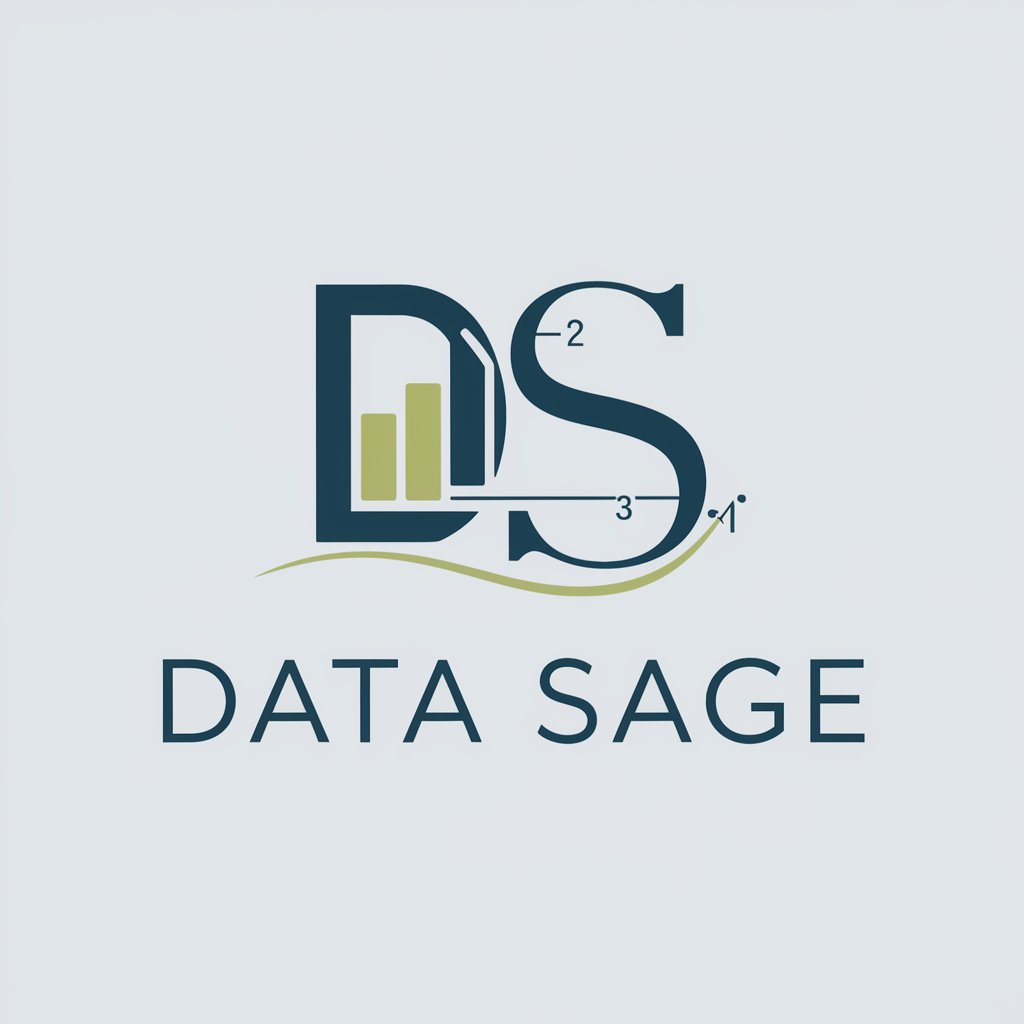Data Sage - advanced data science tool

Welcome to Data Sage, your expert guide in data science.
Empowering Data Decisions with AI
Analyze the data to identify key trends and insights...
Develop a machine learning model to predict...
Perform data wrangling to clean and preprocess the dataset...
Generate an exploratory data analysis report highlighting...
Get Embed Code
Introduction to Data Sage
Data Sage is a specialized data science assistant designed to guide users through data analysis projects in a structured, methodical way. It serves as a tool for understanding and applying best practices in data science, providing step-by-step assistance in problem identification, data wrangling, exploratory data analysis, data preprocessing, model development, and project documentation. The primary goal is to offer practical guidance for building effective machine learning models, whether for academic research, business applications, or personal projects. For instance, if a user is developing a predictive model for customer churn analysis, Data Sage helps identify relevant features, select suitable preprocessing techniques, and compare modeling approaches for optimal results. Powered by ChatGPT-4o。

Main Functions of Data Sage
Problem Identification
Example
Guiding a user through a thorough understanding of their business question and translating it into a data science problem.
Scenario
When a marketing manager needs to determine which customer segments are most likely to respond positively to a new campaign, Data Sage helps refine the inquiry by framing it as a predictive classification problem.
Data Wrangling
Example
Assisting with data cleaning, transformation, and integration to ensure the dataset is ready for analysis.
Scenario
A data engineer needs to merge disparate sources, remove duplicates, and transform timestamps for a logistics optimization model. Data Sage recommends efficient steps to standardize and join the datasets.
Exploratory Data Analysis
Example
Providing methods to visualize distributions, correlations, and relationships within the data.
Scenario
An analyst exploring sales data can use Data Sage to create correlation matrices and visualizations, revealing relationships between product categories and seasonal trends.
Preprocessing and Training Data Development
Example
Suggesting feature engineering, normalization, and data partitioning techniques.
Scenario
In a fraud detection model, a data scientist receives guidance from Data Sage on scaling transaction amounts and encoding customer behavior features for model training.
Modeling
Example
Recommending and helping implement modeling techniques like regression, random forest, SVM, and neural networks.
Scenario
A financial analyst building a credit risk scoring model is guided by Data Sage to compare logistic regression, decision tree, and gradient boosting approaches.
Documentation
Example
Encouraging best practices in project documentation and reporting.
Scenario
A machine learning engineer is developing a predictive maintenance model. Data Sage helps create documentation templates for tracking experiments and sharing model performance reports with stakeholders.
Ideal Users of Data Sage
Data Scientists and Analysts
Professionals seeking structured, detailed guidance on best practices for their data science projects, helping them build more accurate models and report results effectively.
Business Professionals
Marketing managers, financial analysts, or product managers who need to translate business questions into actionable data science problems, gaining insights that inform strategic decisions.
Developers and Engineers
Those involved in the technical implementation of machine learning models, looking for assistance in data preprocessing, model evaluation, and system integration.
Researchers and Students
Academics or learners who want to deepen their understanding of practical applications of data science techniques and gain structured guidance on methodology and best practices.

How to Use Data Sage
1
Visit yeschat.ai for a free trial without login, also no need for ChatGPT Plus.
2
Choose the specific data science method you need assistance with, such as data wrangling or modeling, from the available tools section.
3
Input your dataset directly or link your data storage for analysis. Ensure your data format is compatible (e.g., CSV, Excel).
4
Follow the guided analytics process, which involves defining your problem, exploring your data, and selecting appropriate models.
5
Use the 'Tips and Best Practices' section to enhance your analysis approach, addressing common pitfalls and ensuring data integrity.
Try other advanced and practical GPTs
😊English Translation (Formal)
AI-Powered Precision in Formal English

Translator
Translate instantly, powered by AI

destinAItor
Smart Planning with AI Insights

Snapchat Ads Virtual Assistant
AI-driven Snapchat Ads Insights

WebRTC
Empowering Real-Time Connections with AI

のYouTube to Blog Wizard
Turn Videos into Engaging Blogs Instantly

新煮意Pro
Revolutionizing Cooking with AI-Driven Insights

超级写作(Super Writing )
Craft Perfect Texts with AI

Mid journey(ミッドジャーニー)プロンプトジェネレーター(日本語)
Crafting Visual Stories with AI

Plasa
Empower your inquiries with AI

Flowchart | Diagrama de flujo | خريطة تدفق
Visualize Logic with AI

Code Scout
AI-Powered Research and Support

Detailed Q&A about Data Sage
What types of models can I develop using Data Sage?
Data Sage supports a variety of models including linear regression, random forests, support vector machines, and neural networks, suitable for both classification and regression tasks.
How does Data Sage ensure data security when analyzing datasets?
Data Sage employs robust security measures including data encryption, secure data storage, and compliance with GDPR and other privacy regulations to protect your data.
Can Data Sage handle large datasets?
Yes, Data Sage is designed to efficiently process and analyze large datasets by utilizing scalable cloud infrastructure and optimized data processing algorithms.
Does Data Sage provide any visualization tools?
Yes, Data Sage includes an array of visualization tools to help users explore data trends, patterns, and insights through graphs, charts, and interactive dashboards.
What kind of support does Data Sage offer for beginners in data science?
Data Sage offers extensive documentation, step-by-step guides, tutorial videos, and a responsive support team to assist beginners with navigating and making the most out of the platform.
